Not checking the filter

Within your dishwasher, there is a filter designed to trap food particles and grease, preventing them from re-depositing on your dishes during the wash cycle. However, if this filter becomes clogged, you may find that your dishes come out dirty, greasy, and odorous, despite being washed. It's not just food that can obstruct the filter; hard water can also leave mineral deposits that create a white or gray film on it. When your filter is blocked, it’s essential to clean it.
You don’t have to clean your filter after every use of the dishwasher; typically, a monthly cleaning is adequate. Nonetheless, it’s wise to take a quick look at the filter before loading the dishwasher to avoid running it with a dirty filter. You can clean a soiled filter in your kitchen sink. For routine maintenance, a simple spray is usually sufficient, but a heavily soiled filter may need to be soaked. A soft brush can assist in removing stubborn debris or mineral buildup. Additionally, you can use vinegar to run a cleaning cycle in your dishwasher to help maintain its cleanliness.
Leaving food scraps on dishes

It can be tempting to toss dirty dishes directly into the dishwasher, but that’s not always the best approach. As we know, a dishwasher’s filter is designed to catch food particles, and if it becomes clogged, your dishes won’t be properly cleaned. Leaving large pieces of meat, pasta, mashed potatoes, and other items that can obstruct your filter is a poor choice, resulting in dirty dishes by the end of the cycle.
Large food remnants can also get stuck in the racks, settle at the bottom of the dishwasher, or cling to the dishes themselves. You might find that your dishes feel greasy and slimy or are coated with a fine layer of residue. This means you’ll have to either wash everything by hand or run the dishwasher again. To simplify the dishwashing process, take a moment to scrape off food remnants from your dishes before placing them in the dishwasher. This will also reduce the effort needed to clean your filter.
Pre-rinsing the dishes

While you definitely shouldn't put food scraps in your dishwasher, it's also important not to over-clean your dishes. This may seem counterintuitive, but there's a good reason for it: modern dishwashers are equipped with sensors that measure the dirtiness of the water. The dishwasher adjusts the cycle time based on how dirty the water appears to the sensor. If you pre-wash your dishes, the sensor can't function properly.
In fact, it's best to avoid pre-rinsing your dishes to prevent confusing the sensor. Pre-rinsing is one of the most common mistakes people make with their dishwashers. Not only does it interfere with the sensor's accuracy, but it also wastes time, energy, and water, and is generally unnecessary. Instead, simply scrape off any large food particles, and your dish will be ready for the dishwasher. However, this advice doesn't apply to dishes with dried or stuck-on food. For those, it's best to soak them first to loosen the residue before placing them in the dishwasher, or wash them by hand.
Only half-loading the dishwasher

At times, you may find it necessary to operate your dishwasher even when it's not completely full. Perhaps you urgently need certain items cleaned, or you're heading out for a few days and prefer not to return to unpleasant, dirty dishes. However, as a general rule, it's advisable to refrain from running a partially filled dishwasher, as it can negatively impact your finances, the appliance itself, and the environment. Therefore, even if you're tempted to run a half-full load just to get it over with, it's wiser to wait until the dishwasher is full.
When you choose to run several small loads instead of a couple of larger ones, several consequences arise. Firstly, your dishwasher consumes more energy and water for these smaller loads. This is not only detrimental to the environment but can also lead to significantly higher utility bills. Additionally, these extra cycles place added stress on the dishwasher, potentially shortening its lifespan. This could ultimately cost you more, as you might find yourself needing to replace your dishwasher sooner than expected.
Overloading the dishwasher
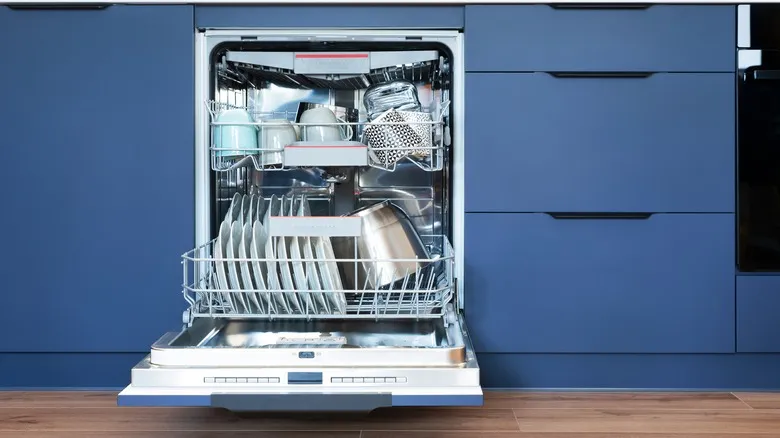
Conversely, there are moments when the dishes accumulate, and you just want to shove everything into the dishwasher and be done with it. However, this approach is not advisable, as overloading the dishwasher prevents it from effectively cleaning all your items. As a result, you may find some dishes still dirty, requiring hand washing or another cycle. This ultimately leads to wasted water, electricity, and time.
Dishwashers operate by spraying water through jets, typically located on the underside of each rack or on a rotating arm. When there are too many dishes packed inside, the water from these jets cannot reach all surfaces, which is why some items may come out clean while others remain dirty. To ensure that the dishwasher jets can thoroughly clean every dish, arrange them in a way that allows the sprayers to access all the dirty areas. This means avoiding stacking dishes on top of one another or nesting bowls together.
Putting glasses and bowls facing up
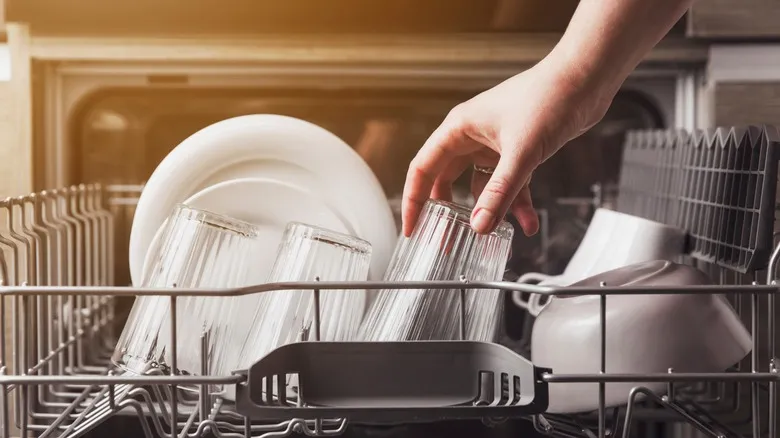
To ensure that your glasses and bowls are properly aligned with the dishwasher jets, it's important to place them face down rather than face up. The "face," or the interior of the cups and bowls, tends to be the dirtiest part, and when they are positioned face up, water struggles to reach them effectively. Loading them face up can result in cups and bowls that still have food residue.
Moreover, placing them face up can lead to water accumulating inside, making it nearly impossible for the dishwasher to rinse it out. This can lead to an unpleasant surprise when you open the dishwasher and find your glasses and bowls filled with dirty, grimy water.
Additionally, glasses and cups should be positioned between the tines of the dishwasher, rather than resting on top of them. This method has several advantages: it maximizes space on the top shelf, ensures that water jets can reach all surfaces, and helps prevent the cups from breaking.
Organizing utensils incorrectly
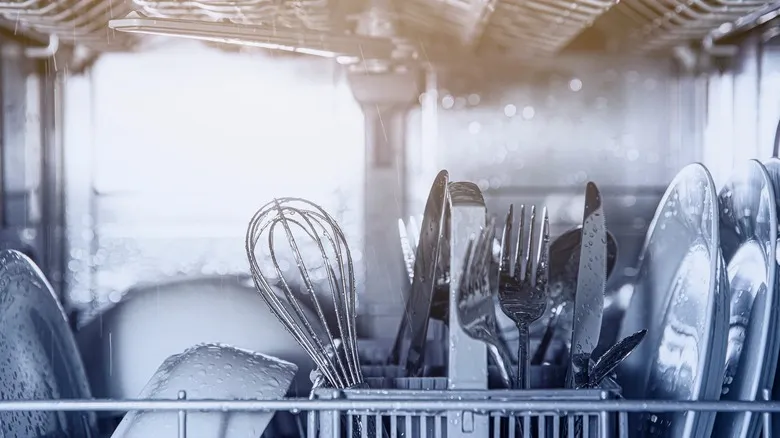
Many modern dishwashers feature a third top rack designed specifically for utensils and cutlery, but a significant number still come with a traditional upright basket located on the bottom shelf. Just as people debate the merits of pineapple on pizza or the proper way to hang toilet paper, there’s no definitive agreement on the best method for organizing utensils in an upright basket. However, there are some important guidelines to follow.
Firstly, knives should always be placed in the cutlery basket with the sharp edge facing down and the handles pointing up to prevent any injuries while loading or unloading the dishwasher. For this reason, many individuals choose to load forks with the tines facing down as well, although some contend that utensils are cleaned more effectively when placed handle-down. It’s also advisable to avoid nesting utensils within the basket; keeping silverware tightly packed together, as it is in a drawer, can hinder the dishwasher's ability to clean each piece thoroughly. Furthermore, larger utensils, such as spatulas and serving spoons, are generally better suited for the top shelf instead of the baskets, as their height may obstruct the spinning mechanism located beneath the top rack.
Putting dishes on the wrong racks

To ensure that every dish is thoroughly cleaned, there are some basic guidelines regarding which items should be placed on each rack of the dishwasher. Generally, plates, large bowls, and pots and pans are best suited for the bottom rack, while mugs, glasses, and smaller bowls should be positioned on the top rack. Dishes that are too tall for the top rack but are forced into that space can break, and oversized items may not receive adequate cleaning on the top rack. However, certain items should always be placed on the top rack, regardless of their size, or washed by hand instead.
Many plastic items, such as food storage containers and children's dishes, should be placed on the top rack rather than the bottom. This is because the heating element is located at the bottom of the dishwasher, which can melt or damage plastic items. If you're uncertain about where to place an item, look for guidance on the bottom. Often, dishes that are not suitable for the bottom rack will have a label indicating "top rack dishwasher safe only," typically accompanied by a symbol featuring a small plate and a larger plate beneath streams of water.
Loading delicate items on the bottom

Plastic items should be kept off the bottom rack of the dishwasher to prevent melting, while fragile objects should also be avoided there to prevent potential damage such as chips, cracks, or discoloration. Instead, these delicate items should be placed on the top rack and may require special handling. Some may even need to be washed by hand rather than in the dishwasher.
Easily breakable items, like china dishes, should be positioned on the top rack to protect them from the heating element and harsher water jets of the dishwasher. All types of glasses should also be placed on the top rack, but long-stemmed wine glasses should never go on the bottom to prevent stem breakage. Additionally, certain delicate items—such as crystal, antique pieces, hand-painted china, or metal-rimmed dishes—should not be placed in the dishwasher at all and should only be washed by hand. If you're uncertain about the proper washing method for an item, consult the label. If there is no label, particularly with antiques, it's best to err on the side of caution and opt for handwashing, especially for valuable or irreplaceable items.
Washing hand wash-only items
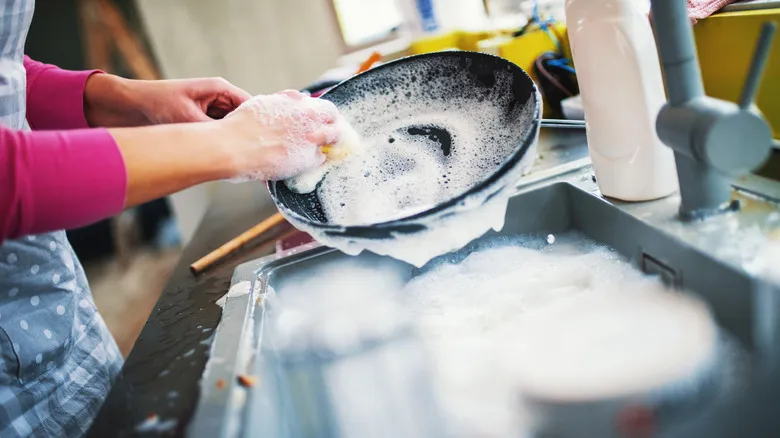
Just as certain items are best placed on the top rack of the dishwasher, there are many that should never be washed in it at all. Most of your everyday kitchenware is safe for the dishwasher; items made from hard plastic, glass, stoneware, and stainless steel typically handle the wash just fine. However, there are several frequently used items that are better off being hand washed.
Items you should avoid putting in the dishwasher include silver and copper, as they can tarnish or lose their luster, and cast iron or non-stick cookware, since the dishwasher can strip away their protective coatings. Wooden items should also be kept out of the dishwasher, as they may warp or crack. This includes wooden cutting boards, which are often mistakenly washed in the dishwasher. Insulated mugs should not be placed in the dishwasher either, as it can compromise their seal and insulation. If you're uncertain about whether an item is dishwasher safe, always refer to the label. A "dishwasher safe" label typically features an image of a small and large plate beneath streams of water.
Placing the detergent in the wrong spot
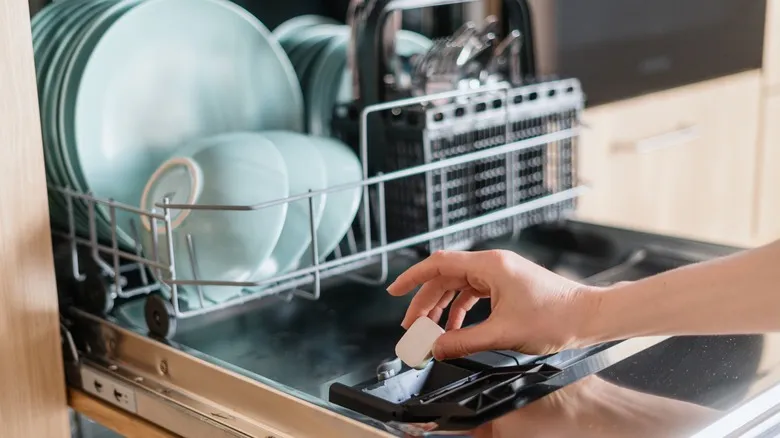
Most people are aware that dishwashing detergent, rather than regular dish soap, is necessary for dishwashers. However, not everyone realizes that the placement of the detergent is important. Generally, dishwasher detergent should be placed in the designated detergent compartment and not elsewhere. This applies to pods as well, unless your dishwasher has a specific compartment designed for them, which some models do.
Dish detergent tips are frequently shared online, particularly on platforms like TikTok, but most of them should be disregarded. Dishwashers are engineered to release detergent at a precise moment during the cycle, and placing it in the wrong spot can disrupt this timing. For instance, you shouldn't place your detergent pod in the silverware basket or at the bottom of the dishwasher, as this can lead to premature release of the detergent, leaving your dishes dirty. Additionally, putting it at the bottom may risk damaging the pod due to the heating element or causing it to stick to it.
That said, there is one exception to this guideline: if you're using an express cycle. However, since dishwashers and detergents can vary, it's best to consult the instructions for both your detergent and dishwasher to confirm the correct placement.
Ignoring rinse aids

Many individuals perceive rinse aids in a similar light to fabric softeners; they may seem like a nice addition but are ultimately seen as non-essential. However, rinse aids, unlike fabric softeners, can be quite beneficial. While they aren't mandatory, if you haven't tried a rinse aid before, it might be worth considering. Rinse aids consist of acids, salts, and surfactants, serving multiple purposes: they help dishes dry more quickly and minimize food residue and hard water spots.
Some dishwashing detergents come with rinse aids included, but not all do. In such cases, you'll need to purchase a separate rinse aid and add it to the designated compartment in your dishwasher. Your dishwasher will dispense the rinse aid at the appropriate time during the wash cycle. If you continue to see hard water stains, it may indicate that not enough rinse aid is being dispensed. Conversely, if you notice rainbow streaks on your dishes, it suggests that too much rinse aid is being released. To resolve this, consult your manual for guidance on adjusting the rinse aid settings.
Not reading the dishwasher manual

While the tips mentioned above can assist you in loading your dishwasher more effectively and minimizing food residue, it's important to note that each dishwasher has its own unique features. The best way to understand how to load your specific dishwasher is to refer to the manual that came with it. Your manual will provide detailed instructions tailored to your model.
In addition to loading instructions, your dishwasher manual offers valuable information about its components, such as the detergent compartment, rinse aid compartment, and filter. It will guide you on where to place different types of detergent and clarify the functions of each setting, as well as how to adjust them. Many manuals also include troubleshooting sections to help you resolve minor issues.
If you purchased your dishwasher new, it should have included a manual. However, if you have a second-hand model, you might not have the manual on hand. To locate one, check inside the dishwasher for the model number. A quick online search using the brand and model number can often lead you to a digital version of the manual.
Recommended

13 Easy Upgrades Your Tuna Sandwich Deserves

How Long Store-Bought Chicken Broth Lasts, Open Or Sealed

How To Clean A Dutch Oven With Burnt On Stains

Use Cottage Cheese To Make A Light, Easy 'Alfredo' Sauce
Next up

